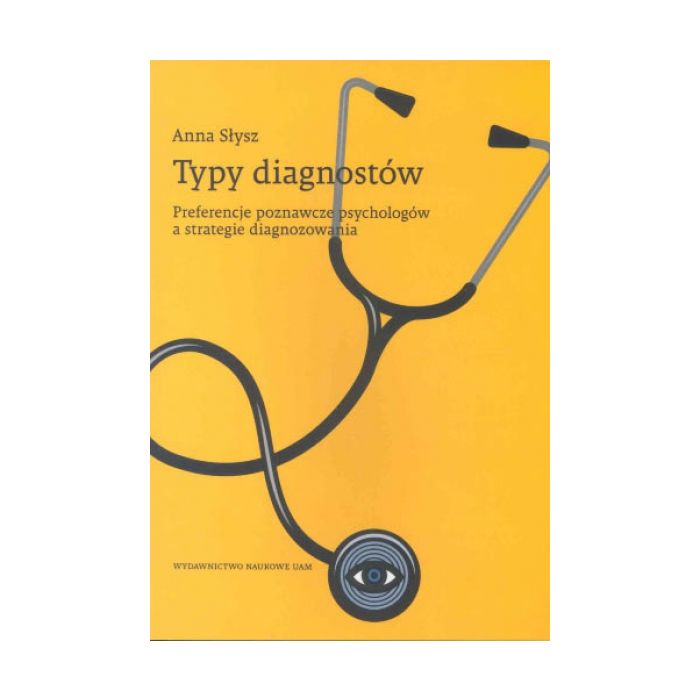Typy diagnostów. Preferencje poznawcze psychologów a strategie diagnozowania
- In Stock: out of stock
- ISBN: 978-83-232-1943-9
- Category: OUTLET, Psychology and Education
- Year of publication: 2009
There are some differences in the ways of assessment among professional psychologists. This empiric publication concerns relationships between psychologists' cognitive preferences (such as: type of mind, need for cognitive closure), clinical experience and strategies used in assessment. The sample included sixty psychologists working in a variety of Clinical Psychology Departments. Case Study - Simulation (AP-S) was one of four instruments used in this investigation. This simulation represents a patient with a schizoid personality disorder. Three strategies were identified during the research process: 1) maximal strategy - psychologists analysed very much information and generated a lot of hypotheses; 2) heuristic strategy - psychologists analysed less information and generated fewer hypotheses and used classical heuristics (cognitive shortcuts), 3) mixed strategy (analytic - heuristic) - reflected theory and intuition used for making diagnosticdecisions. The results of this study have some implications for teaching and training psychological assessment.
Wstęp
Rozdział 1. Charakterystyka procesu diagnozowania
1.1. Sposoby ujmowania procesu diagnozowania
1.2. Struktura myślenia lekarskiego w postępowaniu diagnostycznym
1.3. Specyfika diagnozy psychologicznej
1.4. Modele psychologicznej diagnozy klinicznej
1.5. Systemy klasyfikacji chorób
1.6. Etapy psychologicznej diagnozy klinicznej
1.7. Trafność diagnozy klinicznej i statystycznej
1.8. Zakończenie
Rozdział 2. Rola reguł heurystycznych w procesie diagnozowania
2.1. Znaczenie terminu heurystyka
2.2. Strategie przetwarzania informacji diagnostycznych
2.3. Pozytywne znaczenie heurystyk w diagnozie
2.4. Negatywne aspekty stosowania heurystyk w diagnozie
2.5. Zakończenie
Rozdział 3. Podmiotowe uwarunkowania strategii diagnozowania
3.1. Rola typu umysłu w spostrzeganiu i ocenie informacji
3.1.1. Typy umysłu - podstawy teoretyczne
3.1.2. Relacja mózg- umysł, lokalizacja podstawowych funkcji
3.1.3. Stosowanie heurystyk w zależności od ogólnych preferencji poznawczych
3.2. Potrzeba domknięcia poznawczego jako dyspozycja
3.3. Rola paradygmatu teoretycznego w diagnozowaniu
3.4. Wpływ doświadczenia zawodowego na strategie diagnozowania
3.5. Zakończenie
Rozdział 4. Prezentacja badań własnych
4.1. Określenie paradygmatu badań
4.2. Badania eksploracyjne
4.2.1. Badanie pierwsze
4.2.2. Badanie drugie
4.3. Główne problemy badawcze
4.4. Zmienne i ich operacjonalizacja
4.5. Metody zastosowane w badaniu
4.6. Charakterystyka badanej próby
4.7. Procedura i przebieg badania
4.8. Zakończenie
Rozdział 5. Wyniki badań i wnioski
5.1. Wskaźniki strategii przetwarzania danych diagnostycznych
5.2. Typologia diagnostów
5.3. Psychologiczna charakterystyka wyodrębnionych typów
5.4. Dyskusja nad wynikami
5.5. Implikacje praktyczne
5.6. Zakończenie
Aneks 1. Analiza Przypadku-Symulacja
Aneks 2. Arkusz Oceny Strategii Diagnozowania
Literatura
Diagnosticians' types. Cognitive preferences of psychologists and diagnostic strategies (Summary)
| Detailed information | |
|---|---|
| Publication Version | printed |
| Format | 17,5 x 24,0 |
| Title (EN) | Diagnosticans' types. Cognitive preferences of psychologists and diagnostic strategies |
| Type of publication | Monografia |
| Edition | I |
| Series | Psychologia nr 7 |
| ISSN | 1898-0473 |
| ISBN | 978-83-232-1943-9 |
| Number of pages | 166 |
| Number of publishing sheets | 16,00 |
| Type of binding | paperback |
